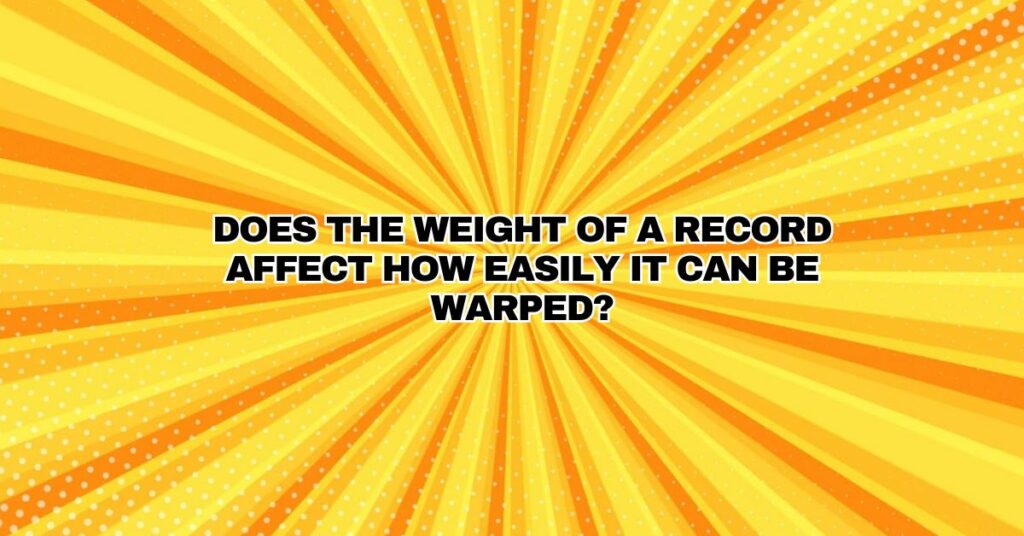Vinyl records, with their warm analog sound and tactile appeal, continue to captivate music enthusiasts worldwide. However, vinyl records are not invincible, and one of the concerns that plagues collectors and audiophiles is the potential for warping. While many factors can contribute to record warping, the weight of the record itself is a subject of intrigue. In this comprehensive article, we’ll explore whether the weight of a record affects its susceptibility to warping and dive into the intricacies of vinyl records and their care.
Understanding the Anatomy of a Vinyl Record
Before delving into the weight-warping relationship, it’s essential to grasp the fundamental structure of a vinyl record:
- The Vinyl Material: Most vinyl records are made of a particular type of vinyl called polyvinyl chloride (PVC). PVC is a thermoplastic, which means it becomes malleable when heated and solidifies when cooled. This property is central to the pressing process of vinyl records.
- The Grooves: The audio information on a vinyl record is stored in a series of grooves. When a turntable stylus travels through these grooves, it translates the physical vibrations into audible sound.
- The Thickness: Vinyl records come in various thicknesses. The most common thickness for standard vinyl records is around 120 to 140 grams, but you can also find heavier variants like 180-gram or 200-gram records.
Does Weight Affect Warping?
The relationship between the weight of a vinyl record and its propensity to warp is not straightforward. Warping can occur due to various factors, and while weight can play a role, it’s just one piece of the puzzle. Here’s a closer look at the factors that contribute to warping and how weight fits into the equation:
- Thickness and Weight: Heavier records, like 180-gram or 200-gram vinyl, are less prone to warping than lighter, thinner records. The additional mass provides stability, making them less sensitive to temperature fluctuations and handling. However, even heavy records can warp if subjected to extreme conditions.
- Temperature and Humidity: Environmental factors play a significant role in warping. Excessive heat can soften the vinyl, causing it to sag or warp. Conversely, cold temperatures can make the vinyl more rigid, potentially leading to warping as well. High humidity can also be problematic, as it can encourage mold growth on records.
- Storage and Handling: The way you store and handle your vinyl records is crucial. Storing records vertically in a controlled environment with stable temperature and humidity levels can help prevent warping. Avoid stacking records horizontally, as the weight of other records can cause warping over time.
- Sunlight Exposure: Direct sunlight, with its intense heat, can quickly warp vinyl records. Never expose your records to prolonged sunlight or extreme heat sources.
- Uneven Pressure: Uneven weight distribution or pressure on a record, such as stacking heavy items on top of it, can lead to warping. This is not directly related to the weight of the record itself but rather to external forces acting on it.
- Poor Pressing Quality: In some cases, records may exhibit inherent warping due to issues during the manufacturing or pressing process. Low-quality pressings or subpar handling at the pressing plant can result in warping.
Preventing Warping and Proper Care
Whether your records are 120 grams or 200 grams, proper care and storage are key to preventing warping:
- Storage: Store your records vertically in sturdy, protective sleeves or jackets. Use proper record storage solutions, such as crates or shelving, to ensure records are well-supported.
- Environmental Control: Maintain a stable environment for your vinyl collection. Keep records away from direct sunlight, extreme heat, and high humidity.
- Cleaning: Regularly clean your records to remove dust and debris, which can affect playback and contribute to warping over time.
- Handling: Handle records by the edges and labels to avoid contact with the grooves. Use an anti-static brush to remove surface dust before playing.
- Turntable Calibration: Ensure your turntable is correctly calibrated to minimize the risk of damaging your records during playback.
In conclusion, while heavier records are generally less susceptible to warping due to their added stability, it’s essential to consider other factors like temperature, humidity, storage, and handling in your efforts to prevent warping. Proper care and maintenance of your vinyl collection are crucial to preserving the cherished analog sound and tactile experience that vinyl records offer.


